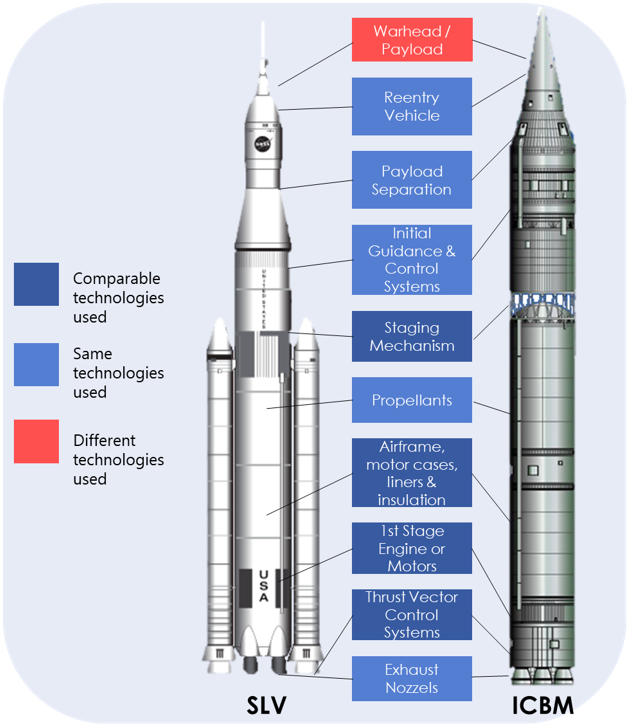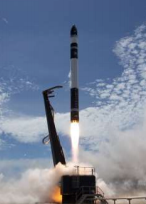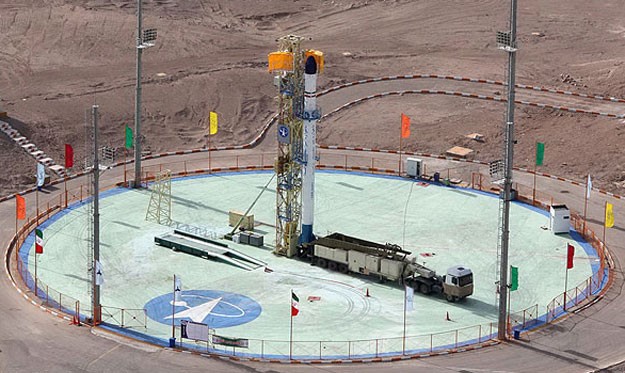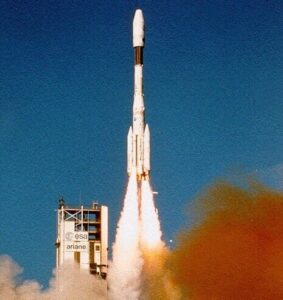
A component of international space law
Although The Hague Code of Conduct (HCoC) is known for its focus on ballistic missiles, it also aims to promote the peaceful use of outer space by requiring the establishment of confidence-building measures (CBMs) among subscribing states. First, HCoC subscribing states undertake to ‘ratify, accede to or otherwise comply with several texts of international space law’ (see box below).
In addition, the HCoC sets out a general framework of best practices within national space programmes to prevent ballistic missile proliferation. That being said, the Code does not intend to regulate the use of space by states in general, nor to impede national space programmes. The text merely sets out general principles to prevent the use of satellite launch vehicle (SLV) programmes to conceal the acquisition of ballistic missiles capable of delivering weapons of mass destruction (WMDs). These guidelines include being vigilant with regard to exports of launcher technologies and the adoption of CBMs on space launches.
The Code’s inclusion of space launchers is clear testimony as to the similarities between SLVs and ballistic missiles. By including both in the HCoC, the international community has recognised the need to avoid the diversion of dual-use components and technologies.
The HCoC and international space conventions
The HCoC requires subscribing states to ratify, accede to or otherwise comply with three major international space conventions:
The Treaty on Principles Governing the Activities of States in the Exploration and Use of Outer Space, including the Moon and Other Celestial Bodies (1967)
The Convention on International Liability for Damage Caused by Space Objects (1972)
The Convention on Registration of Objects Launched into Outer Space (1975)
In brief
The New Space trend – an ongoing innovative transformation of the space sector – has led to a rise of investment in small launch systems.
While an increasing number of nations are gaining access to space, the number of private sector entities investing in this domain is also rising. Meanwhile, small space launch vehicles and ballistic missiles rely on increasingly similar technologies.
In this context, the HCoC encompasses an impor-tant set of transparency and confidence-building measures which cover SLVs, and stress the link with existing international space conventions.
Without being legally-binding or constraining space developments, it sets a framework of best practices which promote cooperation and stability, removing potential ambiguity surrounding emerging space programmes.
Author: Sabrina Barré and Emmanuelle Maitre
Similarities between space launchers and ballistic missile technology
As shown in figure 1, SLVs and ballistic missiles use similar technologies, although their purpose is entirely different. This similarity has increased as a result of recent technological developments.1
Back in the 1980s, the type of fuel technology used could be an indicator of the type of launcher. Small solid propulsion rockets, easier to use but less controllable, were associated with intercontinental ballistic missiles (ICBMs), while large liquid-fuelled stages, that provide more energy but are complex to manipulate, were used for SLVs. Recently however, in North Korea for instance, liquid propellant has been used in ICBM programmes.
Manufacturing frequency also used to be a key indicator as SLVs were mostly produced on order while missiles were produced in series. This is no longer the case as current (smaller) SLVs tend to be manufactured in series. In New Zealand for instance, Rocket Lab’s Electron demonstrated a major technical breakthrough with the 2018 first orbital launch of a mass-produced SLV.


Launch preparations are another area in which previous differences are eroding. Satellite launches traditionally used existing facilities and required extensive preparation. Nowadays, the similarities between SLV and ballistic missile operational preparations impede attempts to distinguish them. In Iran for instance, the SLV Safir uses the standard Transported Erector Launcher (TEL) of the Sajil and Shahab-3 ballistic missiles despite seemingly being used for civilian purposes.
Thus, as stated in the HCoC, it is of the utmost importance for states to clearly communicate their intentions when preparing for a launch, in order to avoid potential misinterpretations.

Current trends and challenges in the space sector
Current trends make the dual approach of the HCoC even more relevant. Indeed, an innovative industrial approach has profoundly changed the space environment over the last two decades. It has enabled more countries to access space. Iran (2008), North Korea (2013), South Korea (2014) and New Zealand (2018) are the latest space-faring nations (see figure 4). Other countries have active programmes today that could lead to the acquisition of launchers in the coming decades (Brazil, Indonesia, South Africa, Argentina, Turkey, Australia, etc.). Not all of these states have currently subscribed to the Code, which is a matter of concern (figure 5).2
This ‘New Space’ dynamic is primarily driven by the miniaturization of satellite technologies, which in turn has encouraged new investments in small launch systems.
Private sector entities also increasingly play a key role in these evolutions, with companies such as Space X or Rocket Lab at the forefront of innovations such as reusable rocket technologies or serial production. This has led a number of countries and start-ups to concentrate their efforts on producing lighter and more efficient space launchers. As more countries and private actors become spacefaring, avoiding confusion between ballistic missiles and small SLVs is essential. These trends highlight the relevance of the HCoC as a key transparency and confidence-building measure in the New Space age.

The importance of the HCoC to promote the peaceful use of space
The HCoC recognises that nations should not be prohibited from enjoying the benefits of space for peaceful purposes, but that they must limit the development of ballistic missiles able to carry weapons of mass destruction. With the rise of New Space, the increase in the number of space-faring nations and the loosening of government top-down control over space activities, the HCoC remains a pillar in the realm of soft law. This importance is emphasized as space is increasingly considered a military domain. The development and testing of systems such as anti-satellite weapons may contribute to the confusion between military and civilian activities.
This soft law agreement thus serves as a key tool in maintaining the balance between promoting peaceful uses of space and reinforcing a norm against WMD delivery vehicle proliferation. As such, it offers a framework of transparency and confidence which can be conducive to enhanced cooperation and progress in the civilian space domain.

About the Hague Code of Conduct
Adopted in 2002, the Hague Code of Conduct against Ballistic Missile Proliferation (HCoC) is a politically binding instrument aiming to limit the proliferation of weapons of mass destruction (WMD) delivery vehicles. Composed of a set of transparency and confidence-building measures, the HCoC is the only existing multilateral instrument to focus on WMD delivery vehicles. The HCoC has reached 143 subscribing states (September 2021) vs 93 at its inception.
When subscribing to the HCoC, states commit to abide by a set of UN treaties and international conventions on space security; to produce an annual declaration regarding ballistic missile capacities and national policy on non-proliferation and disarmament treaties and instruments; and to deliver pre-launch notifications prior to any missile or space launch. Documents are uploaded onto a dedicated online platform managed by Austria, which acts as the HCoC Immediate Central Contact (Executive Secretariat). Subscription to the HCoC is free of charge.
While subscribing states are asked to exercise ‘maximum restraint’ in the development of ballistic capacities, they are proscribed neither from possessing ballistic missiles nor from pursuing space launch activities. In return, subscribing to the HCoC enables states to gain access to information shared by other subscribing states, and to display their political commitment to non-proliferation and disarmament.
1 Gary Milhollin, ‘The Link Between Space Launch and Missile Technology: Presentation at the Asia-Pacific Center for Security Studies,’ Wisconsin Project on Nuclear Arms Control, https://www.wisconsinproject.org/the-link-between-space-launch-and-missile-technology/, last updated on March 16, 2000.
2 Emmanuelle Maitre and Sophie Moreau-Brillatz, ‘The HCoC and Space,’ HCoC Research Paper n°8, Foundation for Strategic Research, to be published.



